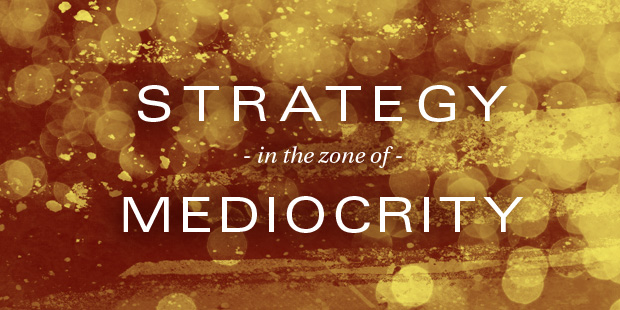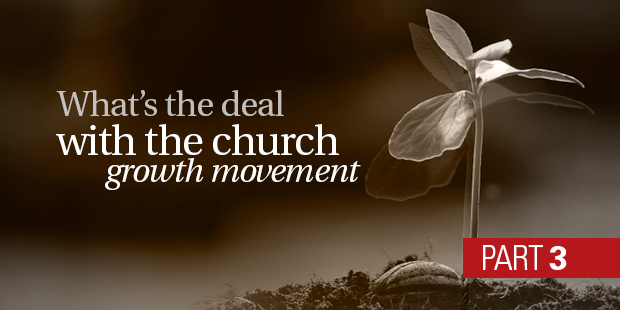Kevin Hendry talks about “the zone of mediocrity” in the language of business, but many churches also find themselves in the same place. Do you recognize some of the symptoms he lists below?
Several years ago I had a discussion with an MBA class on how to recognise good or bad strategy. After a lot of consideration their conclusion was….. good strategy works, it delivers the numbers, bad strategy doesn’t. I attempted to point out some issues in their response, especially that it precluded assessing strategy in advance and that delivering the numbers might ignore important factors related to the quality of those numbers such as sustainability……..but……. I don’t think they were convinced. They liked their focus on results!
I was reminded of this discussion when I read Richard Rumelt’s book, Good Strategy Bad Strategy: The Difference and Why It Matters. Rumelt relies on qualitative factors in rating strategy as good or bad but, while I enjoyed the book, I am not convinced that strategy can be readily categorised in such a black and white fashion. The good – bad dichotomy may be identifiable with numbers based hindsight but it’s much harder to do with foresight, even with a qualitative perspective.
I think about strategy as a hypothesis framed by the choices an organisation makes, an educated bet on an organisation’s future in a complex environment. What complicates strategy even further is that the rules of the game and even the bet itself are constantly changing as internal and external environments evolve. In assessing the merits of an organisation’s strategy up front I mentally position its strategy hypothesis on a continuum of value creation potential. My experience is that many organisations sit in what I call the ‘zone of mediocrity’. Their strategy is not really good or bad! It’s OK given their circumstances. Their performance is average, competition is steady but predictable (sometimes regulated) and the business is modestly profitable, often for a long time, but……… at some stage there is a game changing shift in their environment for some reason, then the trouble starts!
The common thread running through many of the examples of the ‘zone of mediocrity’ that I’ve seen is failure to make clear choices, to decide what to do and especially what not to do. My experience is that this failure is generally driven by problematic strategic conversations, by inadequacies in the strategic dialogue, especially at senior management level but also down through the organisation.
Let’s start by looking at the symptoms of the ‘zone of mediocrity’.
Number 1 is ‘wish list strategy’. This symptom starts with a range of loose statements that get labelled as strategic objectives. Some examples include “we will be a leading provider of …….”, “we will be the firm of choice for all our customers”, “our strategy is growth”. These objectives are often in conflict with each other to some extent but each is presented as being equally important. Priorities are not obvious. That’s where the confusion starts. Then each objective is broken down into another loosely specified list comprised of a mix of lower order objectives (whose relationship to the original wish list is often dubious) and activities to achieve these objectives. However, the distinction between objectives & activities is not clear. The confusion gets worse!
These objectives/activities are usually quantified by lots of performance measures – the K in KPIs is replaced with an A for ‘All’!!! And they’re generally benchmarked against competitors or industry standards. The whole lot is then published in one table, usually in very small font!! People are frustrated because the direction is not clear, they’re not sure what is really important and what is not so important. They’re also not sure how their daily activities fit into the strategy so, more often than not, they ignore it.
The net result – an organisation that bumbles along, one that attempts to be all things to all stakeholders, a sure fire recipe for mediocrity!! If you want some good examples look at how some public sector departments present their strategy on their web sites.
‘Wish list strategy’ is often taken to the extreme with what I call ‘glittering generalities’. In these cases the strategic objectives take the form of grand statements of intent like “We will deliver excellence in customer service, operations and innovation”. It’s the excellence in excellence syndrome. Trade offs are rarely recognised in these organisations, they aim to do everything superbly. Platitudes and buzzwords (Rumelt calls these ‘fluff’) are prevalent but what’s missing is how these objectives will be achieved.
Number 2 is ‘ignoring the elephant in the room’, either consciously or subconsciously. The ‘elephant’ might be an internal issue, a competitive threat, an emerging technology, a societal or environmental challenge but failing to address it is an important warning sign of the ‘zone of mediocrity’. Monsanto’s failure in the late 90s to recognise public opinion against GMO foods is a classic example cited in many case studies. A more recent example is the way major department stores in Australia either ignored or seriously underestimated for years the impact of online shopping on their businesses!
Number 3 is the diversified organisation that promotes itself as being a ‘solutions’ provider, especially a ‘one stop shop solutions’ provider. This loose approach to their value proposition actually represents a serious lack of focus and clarity in these organisations ( I can think of a couple of engineering companies that fit the bill). However, putting ‘one stop shop’ together with ‘solutions’ smacks of an oxymoron – a bit like ‘fun run’, ‘military intelligence’, ‘friendly fire’. It does not really make sense.
The problem with ‘one stop shop solutions providers’ is that their resources, especially their people, are generally spread far too thinly to enable the customisation to specific clients that is at the core of being a solutions provider. John has a theory that this approach is a lead indicator for a sharp decline in share price!!
Why is it that organisations fail to make clear choices? What are the problems in strategic dialogue that lead them into the ‘zone of mediocrity’? My experience is that there are three main culprits.
The first is the Vision – Mission – Values – Objectives – Strategies template which is popular among some consultants. It seems to me that most organisations that follow this hierarchy end up with a strategy that involves being nice to everyone in a long list of ways. It’s just another way to arrive at ‘glittering generalities’. Consider this example from a taxpayer funded public utility operating as a monopoly supplier in only one geographic region of Australia: “Our purpose is to enrich quality of life. Our Vision is to be recognised nationally as a leader in the delivery of products and services, and valued as a trusted partner by our customers and community”. How does this statement guide clear choices???
I actually suggest to organisations that the Vision – Mission etc hierarchy be inverted. Start by getting clarity around strategy linked to feasible & proximate objectives and then iterate through vision, mission etc. The clarity of thinking that emerges from this approach is amazing. Vision, Mission & Values statements actually mean something quite specific that is linked to strategy and can be extrapolated to day to day activities.
The second is the annual, offsite, strategy workshop – the corporate love in! In many companies these event have become rituals of strategy. Held at an up market resort well away from the office the aim is usually strategy development AND bonding. Maybe the focus should just be on bonding???
Before I go on I should own up to the fact that I’ve facilitated far too many of these workshops not to be somewhat prejudicial about them. Nonetheless, I do recognise that, done well, strategy retreats can be a useful vehicle for strategic conversations. But, done poorly, analysis dominates insight and vested interests dominate clear choices. The emphasis is often on ‘populating the boxes’ of strategic management tools (no more SWOT analyses, please!). Flip chart pages & post-it notes are plastered all over the walls, generating long lists of activities that masquerade as strategy but are destined to be ignored. Inadequate preparation, organisational politics, poor group dynamics, and an ill conceived agenda torpedo many of these ideas are problematic right at the start, despite the fact that they are diligently captured on the walls.
The third culprit, strategic planning is a commonly misused strategy process. Its problems have been well dissected in the literature so I will not say much about them here. I should emphasize that I am not against strategic planning per se, just the way it is often practised in organisations. There is usually a heavy reliance on analysis at the expense of synthesis. Lots of information is collected using many of the tools of strategic management. It’s all then put into a ‘black box’, often operated by someone in a staff rather than a line management role and then out pops a nicely worded strategic plan.
The problem here is that the strategic logic is either missing or faulty. Often the dominant logic of the organisation takes over and the plan involves doing more of what worked in the past, regardless of changes in the business environment. Alternatively, the plan emphasises wish lists, there is no clear strategic logic, and the organisation tries to be all things to all stakeholders.
Whatever the symptoms and however it arises, the ‘zone of mediocrity’ is a common problem, much to the detriment of shareholders and stakeholders. Getting outside the zone requires hard choices and that is difficult!!
Read more on the topic here.

Tags: Kevin Hendry, Strategy, Vision Frame
|
What is MyVisionRoom? > | Back to Vision >































